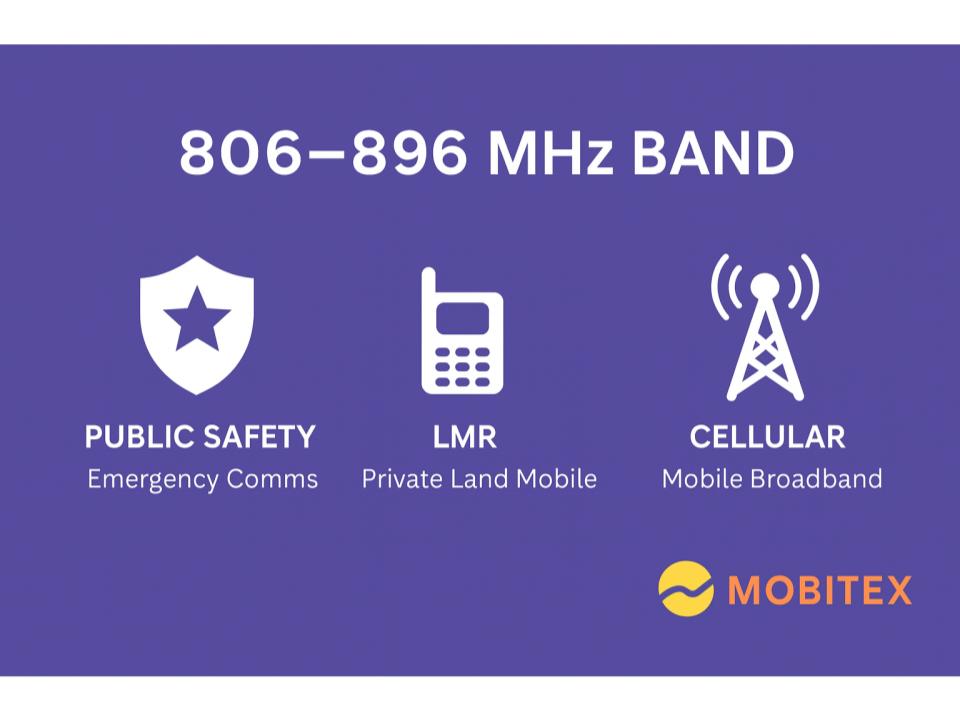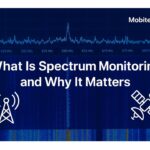Frequency
863 MHz
Range
851–869 MHz
Band Group
UHF (300–1000 MHz)
🌐 Summary
The 863 MHz allocation is part of the UHF (300–1000 MHz) spectrum. This range is used worldwide for critical applications that keep our communications and infrastructure running smoothly. On this page we highlight how each band is applied in real systems, from regulatory assignments to everyday devices. Our goal is to make spectrum data clear and practical for engineers, regulators, and enthusiasts alike.
Key uses of this band include: 863 MHz: Public Safety and Specialized Mobile Radio (SMR) downlink paired with 806–824 MHz uplink; Mobile, Fixed; Narrowband/Trunked LMR downlinks; LTE/NR smartphones, legacy GSM/CDMA devices; LPWAN sensors/meters/trackers.
800 MHz public safety/SMR base transmit (851–869 MHz): trunked P25/DMR/SMR systems; outcomes of 800‑MHz rebanding reflected here.

🔍 Explore the full RF Spectrum database
📡 Band & Geometry key
| Field | Value |
|---|---|
| Wavelength (m) | 0.348 |
| Waveforms | Analog/digital PMR, P25, TETRA, LTE, 5G NR |
| Antenna Form Factor (Typical) | ¼-wave ≈ 8.69 cm |
| Band Family | LMR/Public Safety |
| Band | 800 MHz Public Safety / SMR — Downlink |
| Primary Common Name | Public Safety / SMR DL |
| FSPL @ 1 km [dB] | 91.160215914304 |
| FSPL @ 10 km [dB] | 111.1602159143 |
| Fresnel Radius @ 1 km (m) | 9.3220728850238 |
| Band Group | UHF (300–1000 MHz) |
| Tax Band Family | UHF |
| Tax Band Class | 800/850 MHz Cellular & SMR (806–896) Band |
🧩 Applications & Usage
| Field | Value |
|---|---|
| Primary Application | Public Safety and Specialized Mobile Radio (SMR) downlink paired with 806–824 MHz uplink |
| Lower Neighbor Use | No adjacent allocation defined |
| Upper Neighbor Use | Cellular 850 (CLR) — Downlink |
| Typical Services Devices | Narrowband/Trunked LMR downlinks |
| Market Common Devices | LTE/NR smartphones, legacy GSM/CDMA devices |
| Refarming Use | No |
| Device Ecosystem Size | Medium (100–1000 models) |
| Device Hotspots (MHz) | 868.1/868.3/868.5 |
| Device Category | LoRa / LoRaWAN |
| Typical Use Cases | LPWAN sensors/meters/trackers |
| Modulation (Device) | LoRa (CSS) |
| Channel Width (Device) [kHz] | 125–500 |
| Device Region Profiles | EU: 868; US: 902–928; AU/NZ: 915–928; AS923 variants |
| Per-Region EIRP Or Duty (Device) | EU ≤14 dBm; US up to 30 dBm class (gateway) |
| Allocation Relevance (Device) | ISM LPWAN allocations |
| Adjacent-Band Collision Risks (Device) | 915 MHz overlaps Z-Wave/RFID/smart meters |
| Example Devices Or Skus | Cellular (2G/3G Legacy Devices) |
| Common Protocols | LoRa (868 MHz); Sigfox (regional); Short-Range Devices (SRD); wM-Bus (868 MHz); LTE; 5G NR; GSM/EDGE; UMTS (legacy); Analog FM (12.5 kHz); DMR; P25 (region); TETRA (region) |
🗒️ Notes
| Field | Value |
|---|---|
| Receiver Selectivity Notes | – |
| Interference Notes | Adjacent cellular downlinks; filtering needed |
| Compatibility Risk Notes | – |
| Notes | 800 MHz public safety/SMR base transmit (851–869 MHz): trunked P25/DMR/SMR systems; outcomes of 800‑MHz rebanding reflected here. |
| Propagation Notes | Strong coverage, good indoor penetration |
⚙️ Technical Rules
| Field | Value |
|---|---|
| Lower Band Frequency Limit | 851 |
| Upper Band Frequency Limit | 869 |
| EIRP Indoor Limits | Base stations per license |
| EIRP Outdoor Limits | Base EIRP per license (high) |
| PSD Limit | — |
| Emission Mask Class | LMR/SMR trunked |
| Guardband Minimum [kHz] | 12.5 |
| Typical Bandwidths | 5, 10, 20 MHz |
| Autocalculated Bandlimits | No |
| Typical Bandwidths (Estimated) | 5, 10, 20 MHz |
| Max EIRP [dBm] | EU ≤14 dBm; US up to 30 dBm class (gateway) |
| Power Source Or Duty Profile (Typical) | Battery sensors; mains gateways |
| Channelization Plan | 5, 10, 20 MHz |
| Channelization | 25 kHz (legacy); 12.5 kHz narrowband; LTE/NR blocks |
| Guard Band Requirement | – |
| OOB Emission Limit [dBm/MHz] | -13 (baseline) |
| Spurious Emission Limit (dBm) | -30 (baseline) |
| RX Blocking Min [dBm] | -15 (planning) |
| Duplexing | FDD |
| Duplexing Information | FDD: 806–824 MHz (PS/SMR UL) uplink / 851–869 MHz (PS/SMR DL) downlink |
| Uplink Pairing | 806–824 MHz (PS/SMR UL) |
| Downlink Pairing | 851–869 MHz (PS/SMR DL) |
| Paired Band Info | – |
| Max EIRP [dBm] | – |
| Channelization Block Size | – |
| 3GPP Band Number | |
| Example 3GPP Bands | – |
| LTE Uplink Bands | – |
| LTE Downlink Bands | Band 26 |
| NR Uplink Bands | – |
| NR Downlink Bands | n26 |
| Guard Bands | – |
| Protocol Or Standard | LoRaWAN |
🌎 Country Overrides
| Field | Value |
|---|---|
| Tax Service Category | Other / Various |
| Tax License Type | Licensed / Service-Specific |
| Tax Regions | Global / Varies |
| ITU Region 1 (Europe, Africa, Middle East (west of Persian Gulf), Western Russia & Mongolia) | Mobile, Fixed |
| ITU Region 2 (North America, South America, Central America, Caribbean, Greenland, Eastern Pacific Islands (Americas region)) | Mobile, Fixed |
| ITU Region 3 (Asia, Australia, Pacific Islands, Oceania, Indian Subcontinent, East Asia & Southeast Asia) | Mobile, Fixed |
| License Type | Licensed public safety / SMR |
| Primary Application | Public Safety and Specialized Mobile Radio (SMR) downlink paired with 806–824 MHz uplink |
| Primary Services | Mobile, Fixed |
| Spurious Emission [dBm] | -30 (baseline) |
| Lower Neighbor Use | No adjacent allocation defined |
| Upper Neighbor Use | Cellular 850 (CLR) — Downlink |
| Licensing Model | Licensed (Public safety / LMR) |
| Typical Services Devices | Narrowband/Trunked LMR downlinks |
| US FCC Alloc | Public Safety / LMR (Downlink)– |
| CA IC Alloc | Public Safety / LMR (Downlink)– |
| UK Ofcom Alloc | LMR (regional)– |
| US Ref | 47 CFR Part 90 (Private Land Mobile) |
| Typical Bandwidths | 5, 10, 20 MHz |
| Market Licensing Model | Auctioned (IMT) |
| Market Common Devices | LTE/NR smartphones, legacy GSM/CDMA devices |
| Fresnel Radius (1st, 1 km) [m] | 9.3220728850238 |
| Typical Bandwidths (Estimated) | 5, 10, 20 MHz |
| Auction Status | – |
| Refarming Use | No |
| Typical Site Spacing km | 2 / 8 |
| Device Ecosystem Size | Medium (100–1000 models) |
| Traffic Load Share | Coverage-heavy, low capacity share |
| Device Hotspots (MHz) | 868.1/868.3/868.5 |
| Device Category | LoRa / LoRaWAN |
| Typical Use Cases | LPWAN sensors/meters/trackers |
| Typical Center Frequencies [MHz] | EU 868 (125 kHz); US 915 (125/500 kHz); EU 433 |
| Rule Part (Fcc Or Region) | FCC Part 15.247; ETSI EN 300 220 |
| Modulation (Device) | LoRa (CSS) |
| Channel Width (Device) [kHz] | 125–500 |
| Device Region Profiles | EU: 868; US: 902–928; AU/NZ: 915–928; AS923 variants |
| Per-Region EIRP Or Duty (Device) | EU ≤14 dBm; US up to 30 dBm class (gateway) |
| Allocation Relevance (Device) | ISM LPWAN allocations |
| Adjacent-Band Collision Risks (Device) | 915 MHz overlaps Z-Wave/RFID/smart meters |
| Example Devices Or Skus | Cellular (2G/3G Legacy Devices) |
| Antenna Form Factor (Typical) | ¼-wave ≈ 8.69 cm |
| Power Source Or Duty Profile (Typical) | Battery sensors; mains gateways |
🛡️ Regulatory & Neighbors
| Field | Value |
|---|---|
| Lower Band Frequency Limit | 851 |
| Upper Band Frequency Limit | 869 |
| Rx Blocking Min dBm | -15 (planning) |
| Lower Neighbor Use | No adjacent allocation defined |
| Upper Neighbor Use | Cellular 850 (CLR) — Downlink |
| Lower Neighbor Band | Cellular 850 (CLR) — Uplink (segment) |
| Lower Neighbor Range | 836.000–849.000 MHz |
| Upper Neighbor Label | Cellular 850 (CLR) — Downlink |
| Upper Neighbor Range | 870.000–894.000 MHz |
| Adjacent-Band Collision Risks (Device) | 915 MHz overlaps Z-Wave/RFID/smart meters |
| Real-World Range (Indoor/Outdoor) | Urban 1–3 km; Suburban 2–10 km; Rural 10–20+ km |
| US FCC Alloc | Public Safety / LMR (Downlink)Public Safety / LMR (Downlink) |
| CA IC Alloc | Public Safety / LMR (Downlink)Public Safety / LMR (Downlink) |
| UK Ofcom Alloc | LMR (regional)LMR (regional) |
| Regulatory References | US: 47 CFR Part 90 (Private Land Mobile); CA: ISED RSS‑119 (Land Mobile 27.41–960 MHz); UK: Ofcom PMR/Business Radio (UK FAT) |
| Global Harmonization | Global |
| Crossborder Coordination | High |
| Sharing Mechanism | – |
| Auction Status | – |
| Guard Or Pair | – |
📈 Market & Measurements
| Field | Value |
|---|---|
| Noise Floor | -110 dBm (est.) |
| Interference Cases | – |
| Lower Neighbor Range | 836.000–849.000 MHz |
| Upper Neighbor Range | 870.000–894.000 MHz |
| Interference Notes | Adjacent cellular downlinks; filtering needed |
| Market Licensing Model | Auctioned (IMT) |
| Market Commercial Value | High-value IMT band |
| Market Common Devices | LTE/NR smartphones, legacy GSM/CDMA devices |
| Market Deployment Density | Dense urban, broad rural coverage |
| Noise Floor (Estimated) | -110 dBm (est.) |
| Market Commercial Value (Estimated) | High-value IMT band |
| Ecosystem Maturity | Emerging |
| Indoor Penetration | Good |
| Known Interference | No major interference issues noted |
| Device Ecosystem Size | Medium (100–1000 models) |
| Real-World Range (Indoor/Outdoor) | Urban 1–3 km; Suburban 2–10 km; Rural 10–20+ km |
| Antenna Form Factor (Typical) | ¼-wave ≈ 8.69 cm |
| Ecosystem Maturity | Emerging |
| Device Ecosystem Size | Medium (100–1000 models) |
| Chipset Availability | Specialized vendors (Motorola, Airbus) |
| Operator Deployments | Regional/national public safety agencies |
| Technology Generations Deployed | LMR / TETRA digital voice |
| Roaming Support | No |
| Traffic Load Share | Coverage-heavy, low capacity share |
| Indoor Penetration | Good |
| Known Interference | No major interference issues noted |
| Occupancy | Medium |
| Occupancy Bucket Pct | 10–30% |
| Latency Profile | – |
| Common Channels Or Profiles | EU868: 863–870; US915: 902–928; EU433: 433.05–434.79 |
| Security Features | AES-128 network/app keys |
| Lbt Or Fhss Requirement | EU: LBT/duty-cycle; US: hopping/dwell |
| Popularity (Installed Base) | High |
| Coexistence Tips | Use sub-band plans; ADR; avoid continuous beacons |
| Latency Class | Not critical / ALOHA |
| Device Hotspots (Scoped && Tagged) | – |
